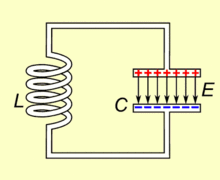I generally can't understand the operation of an LC circuit that is I cannot visualize it. I have a few doubts regarding that, please explain me?
Operation:

Animated diagram showing the operation of a tuned circuit (LC circuit).The oscillations are slowed down; in an actual tuned circuit the charge oscillates back and forth tens of thousands to billions of times per second.
If a charged capacitor is connected across an inductor, current will start to flow through the inductor, building up a magnetic field around it and reducing the charge, and therefore the voltage, on the capacitor. Eventually all the charge on the capacitor will be gone and the voltage across it will reach zero. However, the current will continue unchanged in accordance with Faraday's law of induction, which requires that for the current to change in an inductor, a voltage must be applied to it (this is analogous to Newton's First Law for velocity, mass and force). No energy is required for this provided the current remains constant. However, as the current continues to flow, the capacitor will re-acquire charge of the opposite sign, and its terminal voltage will rise again with reversed polarity. This applies a voltage to the inductor which is now in opposition to its current, so the current now falls. Again this in accordance with Faraday's Law. The falling inductor current and rising capacitor voltage indicate a transfer of energy from the inductor to the capacitor. This is analogous to a moving mass colliding with a spring, and compressing it. When the magnetic field has completely dissipated the current will momentarily stop, and the charge will again be stored in the capacitor, with a polarity opposite to its original one. This will complete half a cycle of the oscillation. The process will then begin again in reverse, with the current flowing in the opposite direction through the inductor.
For more details visit http://en.wikipedia.org/wiki/LC_circuit where I found this stuff.
Doubts:-
-
At the beginning 5v appears across the inductor, after that instant current flowing must increase in the inductor, since the current flows through the inductor to the opposite plate of the capacitor the charges are neutralised. Eventually the voltage across the capacitor decreases, This must lead to decrease in voltage across the inductor also, which then causes the current to increase slowly inside an inductor and thus when the voltage is zero across the capacitor , current must be almost zero in the inductor…..But it is assumed that 5v appears across the inductor constantly no matter what is the voltage across the capacitor. Why is it assumed so, due to this assumption we have charging and discharging across the capacitor??
-
Let that assumption be true (Consider),Then after the capacitor has reached zero volts, it is said that the current still flows, But where is the source of charge for it. Without charge how can current flow, i.e there is no source no electrons or positive ions for the current to flow, Doesn't this disobey the law of conservation of energy.
-
Can anyone please explain to me this circuit conceptually?

Best Answer
The inductor starts discharging the voltage across the capacitor. At some point later that voltage is zero but the current is not zero. The energy in the capacitor due to its initial voltage is totally transferred to the inductor in the form of current.
Now we have the reverse situation. That inductor energy starts pumping back into the capacitor and, after the same period of time, the energy is all taken back to the capacitor in the form of a reversed voltage. The cycle repeats.
Go look up the energy equations for a capacitor and inductor and try and visualize this. Also look up the base equations that relate current and voltage to inductors and capacitors respectively.
You can also think of it like a flywheel tethered with an elastic rope. You can turn the flywheel so as to build up tension in the rope. Then let go. The flywheel starts turning the opposite way and at some time later the elastic rope has no tension in it. Because the flywheel has mass it continues spinning but is slowed down by the rope re tensioning. Eventually, the flywheel stops but, because there is energy in the rope the flywheel starts building up speed in the opposite way.
The equations are pretty much the same for this mechanical analogy and the LC circuit.